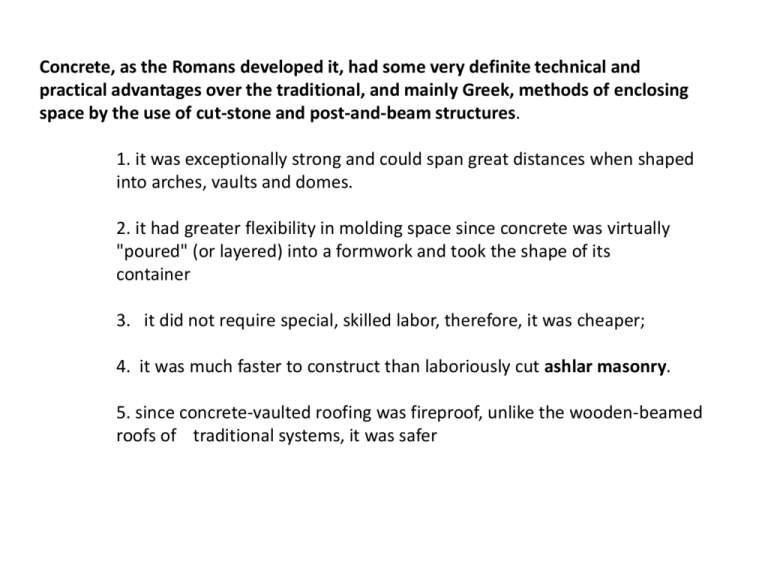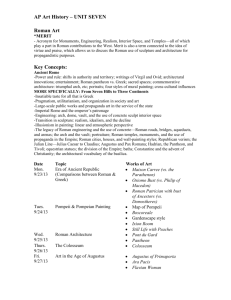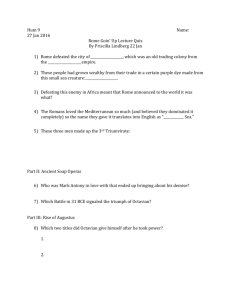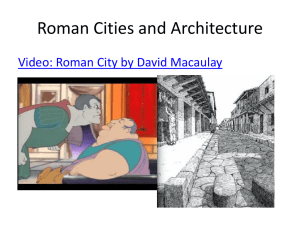Concrete, as the Romans developed it, had some very definite
advertisement

Concrete, as the Romans developed it, had some very definite technical and practical advantages over the traditional, and mainly Greek, methods of enclosing space by the use of cut-stone and post-and-beam structures. 1. it was exceptionally strong and could span great distances when shaped into arches, vaults and domes. 2. it had greater flexibility in molding space since concrete was virtually "poured" (or layered) into a formwork and took the shape of its container 3. it did not require special, skilled labor, therefore, it was cheaper; 4. it was much faster to construct than laboriously cut ashlar masonry. 5. since concrete-vaulted roofing was fireproof, unlike the wooden-beamed roofs of traditional systems, it was safer Arch: It is significant because it converts tensile stresses in spanning structural members into compression stresses only. Stone is weak in tension and cannot span significant distances without collapsing under its own weight. By configuring it into an arch, significant spans can be achieved. The Roman round arch contains "voussoirs" (voo/swars'), or bricks. The "keystone" is the center voussoir that supports the other bricks. The push or thrust of the cemented voussoirs push outward and downward in the arch. A row of arches is called an "arcade." If a person takes the legs of an arch and stretches them length-wise, this is called a "barrel vault." Barrel vaults are used today as entrances and exits in stadiums. Before you arrive at your seat at a baseball or football game, you probably will have to walk through a barrel vault. In a tall building, such as a church, where two barrel vaults meet and divide each other into half, this is a "groin vault." A groin vault supports high ceilings and allow a building to have several entrances and exits, at least four. The Colosseum or Flavian Amphitheater was begun by Vespasian, inaugurated by Titus in 80 A.D. and completed by Domitian. It was the first permanent amphitheater to be built in Rome. The amphitheater is a vast ellipse with tiers of seating for 50,000 spectators around a central elliptical arena. Below the wooden arena floor, there was a complex set of rooms and passageways for wild beasts and other provisions for staging the spectacles. This was called the hypogeum. Eighty walls radiate from the arena and support vaults for passageways, stairways and the tiers of seats. The three tiers of arcades are faced by threequarter columns and entablatures, Doric in the first story, Ionic in the second, and Corinthian in the third. HYPOGEUM Gladiators were either slaves or prisoners of war and were sometimes given the chance to fight for their freedom. It is estimated that over 500,000 people and close to a million animals died throughout the time period that the colosseum was used for gladiatorials and hunting events. In 107 CE, Emperor Trajan is said to have celebrated his victories in Dacia with contests involving 11,000 animals and 10,000 gladiators within 123 days. Roman Sculpture Verism Roman sculpture sought truthfulness -- verism -- in art beyond all else, at least initially. Roman sculpture was determined to portray the individual as he or she actually looked, whether an ordinary person or an emperor. That the appearance of an individual was important and says something about the value of the individual in Roman society. Romans believed that each family had a unique genius, or spiritual gift. Caesar claimed his family was descended from the Trojan hero Aeneas, and from the goddess Aphrodite. These are impressive ancestors indeed! This pedigree was meant to impress Romans that his genius was truly divine and was associated with the foundation of Rome itself. The whole family--dead and alive--were brought to be present at important occasions. Romans loved commemorative portrait busts to honor the departed ancestors, a tradition with a long history in Western Civilization. The statue of Augustus from Livia's villa at Prima Porta is a marble copy of a bronze statue that celebrates the return in 20 BCE of the military standards captured by the Parthians in 53 after the defeat of Crassus at Carrhae. It was probably set up in 15 CE, the year after Augustus' death. It is 7 ft. (2.08 m.) tall (Augustus was 1.70 m., about 5'7") and shows him as a young man. He is barefoot (a sign of divine status) and Cupid (riding on a dolphin beside his right foot) reminds the viewer of Venus, the divine ancestress of the family of Augustus, the gens Iulia. Augustus holds a spear in his left hand, and his right hand is extended as he addresses his armies. His stance is that of the Doryphoros (spear-bearer) by the fifth century Greek sculptor, Polyclitus . The shoulder-clasps of the cuirass (breastplate) are in the form of sphinxes: the Sphinx was the image on Augustus' seal (later he used an image of Alexander, and finally his own portrait). Roman Houses The First Style Roman wall painting, "Incrustation" (right) is thought to imitate Greek painting that created flat areas of color and 'faux" finishes (like a fake marble or oak finish). Second Painting Style - In the second style Roman wall painting, called the "architectural style," space extends beyond the room with various perspective ("illusion of threedimensional space on a flat twodimensional surface) devices. Roman artists came close to developing a true linear perspective In the Third Style Roman Wall Painting, called the "Ornate Style," pictorial illusion is confined to "framed" images, where even the "framing" is painted on. The overall appearance is flat rather than a 3-D illusion of space The Fourth Style Roman Wall Painting, called the "Intricate Style," confines full three-dimensional illusion to the "framed images," which are placed like pictures in an exhibition. The images themselves do not relate to one another nor do they present a narrative, as in the Second Style. The Fourth Style is also characterized by the open vistas and the use of aerial perspective, as well as the elaborate architectural framing








